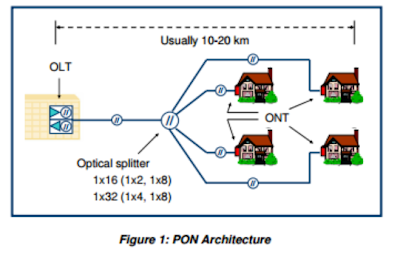Fiber Network Infrastructure
PASSIVE OPTICAL NETWORKS (PON)
 PON uses powered equipment in the central office and customer premise. In the outside plant, it uses passive splitters and couplers to divide bandwidth among up to 32 users over a distance of 10-20km.
PON uses powered equipment in the central office and customer premise. In the outside plant, it uses passive splitters and couplers to divide bandwidth among up to 32 users over a distance of 10-20km.A Passive Optical Network (PON) consists of an optical line terminator (OLT) located at the Central Office (CO) and a set of associated optical network terminals (ONT) to terminate the fiber – usually located at the customer’s premise. Both of these devices require power. PON gets its name because instead of using powered electronics in the outside plant, it instead uses passive splitters and couplers to divide up the bandwidth among the end users – typically 32 over a maximum distance of 10-20km. Because this is a shared network, it is sometimes referred to as Point to Multipoint or P2MP.

ACTIVE NETWORKS (AN)
Similar to PON, Active networks use powered, hardened equipment in the field, enabling them to provide a dedicated “pipe” to each subscriber. Active networks can serve a virtually unlimited number of subscribers over an 80km distance.An Active network looks very similar to a PON, however, there are three main differences. First, instead of having passive, unmanageable splitters in the field, it uses environmentally hardened Ethernet electronics to provide fiber access aggregation. Second, instead of sharing bandwidth among multiple subscribers,
each end user is provided a dedicated “pipe” that provides full bi-directional bandwidth. Because of its dedicated nature, this type of architecture is sometimes referred to as Point to Point (P2P). The third architectural difference between PON and Active is the distance limitation. In a PON network, the furthest subscriber must be within 10-20km from the CO, depending on the total number of splits (more splits = less distance). An Active network, on the other hand, has a distance limitation of 80km, regardless of the number of subscribers being served. The number of subscribers is limited only by the switches employed, and not by the infrastructure itself, as in the case of PON.
Yorumlar
Yorum Gönder